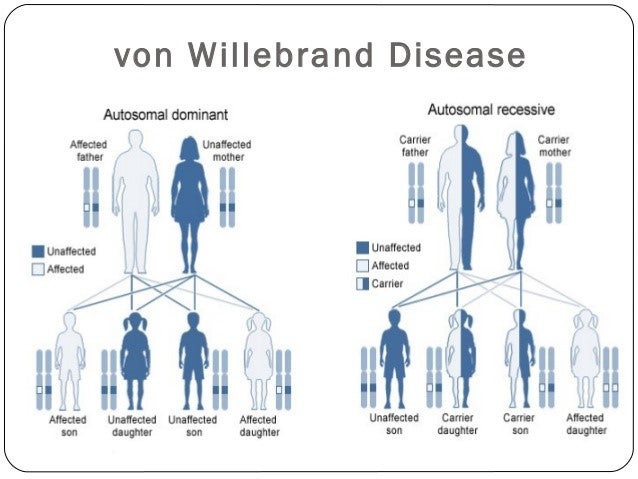von Willebrand Disease
What is von Willebrand Disease?
Von Willebrand disease (vWD) is an inherited bleeding disorder caused by low levels of a protein called von Willebrand factor, which helps blood to clot by acting as glue for platelets. It is often compared to hemophilia but is a different disease and usually milder than hemophilia. It is the most common inherited bleeding disorder in the United States.
Symptoms
Many children with mild cases of vWD have no visible symptoms. Others can experience symptoms such as:
- Frequent large bruises from minor bumps or injuries
- Frequent or prolonged nose bleeds
- Heavy or prolonged menstrual bleeding in females
- Unusually prolonged or heavy bleeding from the gums during teeth cleaning or other dental procedures
- Unusually heavy bleeding after surgery
- Blood in the urine or stool
- Excessive bleeding from minor cuts
If a doctor suspects a child of having vWD, he will ask about a family history of bleeding or bleeding disorders.
Three Main Types
- Type 1 – (60-80% of patients) The most common and mildest form in which there are lower than normal levels of von Wilebrand factor and, possibly reduced levels of factor VIII in the blood.
- Type 2 – (15-30% of patients) in which von Willebrand factor does not function the way it is supposed to; includes subtypes 2A, 2B, 2M and 2N, which are caused by different gene mutations and treated differently.
- Type 3 – (5-10% of patients) the rarest and most severe type in which patients have virtually no von Willebrand factor and low levels of factor VIII, which means they are likely to experience severe bleeding.
- Aquired vWD – this type of vWD in adults results after a diagnosis od an autoimmune disease, such as lupus, or from heart disease of some types of cancer. It can also occur after taking certain medications.
Genetic Disposition
vWD is carried on chromosome 12 and occurs equally in men and women.

Diagnosis
To evaluate you for von Willebrand disease, your doctor will likely ask you detailed questions about your medical history and check for bruises or other signs of recent bleeding. Your doctor will also likely recommend the following blood tests:
- Von Willebrand factor antigen. This test determines the level of von Willebrand factor in your blood by measuring a particular protein.
- Ristocetin cofactor activity. This test measures how well the von Willebrand factor works in your clotting process. Ristocetin, which is an antibiotic, is used in this laboratory testing.
- Factor VIII clotting activity. This test shows whether you have abnormally low levels and activity of factor VIII.
- Von Willebrand factor multimers. This test evaluates the specific structure of von Willebrand factor in your blood, its protein complexes (multimers) and how its molecules break down. This information helps identify the type of von Willebrand disease you have.
The results of these tests can fluctuate in the same person over time due to factors such as stress, exercise, infection, pregnancy and medications. So you may need to repeat some tests. If you have von Willebrand disease, your doctor may recommend that family members undergo the same or similar tests to determine if this condition runs in your family.
Treatment
Even though von Willebrand disease is a lifelong condition with no cure, treatment can help prevent or stop bleeding episodes. Your treatment depends on the type and severity of your condition, how you’ve responded to previous therapy, and your other medications and conditions. Your doctor may suggest one or more of the following treatments to increase your von Willebrand factor, strengthen blood clots or, in women, control heavy menstrual bleeding:
- Stimate/Desmopressin – This medication is available as an injection (DDAVP) or nasal spray (Stimate). It’s a synthetic hormone, similar to the natural hormone vasopressin. It controls bleeding by stimulating your body to release more von Willebrand factor already stored in the lining of your blood vessels. DDAVP is usually effective in people with type 1 and some subtypes of type 2 disease.
Many doctors consider DDAVP the first treatment to use in the management of von Willebrand disease. Some women use the nasal spray (Stimate) at the beginning of their menstrual periods to control excessive bleeding. It can also be effective when used before a minor surgical procedure.
- Contraceptives – For women, these can be useful for controlling heavy bleeding during menstrual periods. The estrogen hormones present in birth control pills can boost levels of von Willebrand factor and factor VIII activity. This effect is likely available with birth control patches, though further study is needed to confirm it.
- Amicar (Clot-stabilizing medications) – These anti-fibrinolytic medications — such as aminocaproic acid (Amicar) and tranexamic acid (Cyklokapron, Lysteda, others) — can help stop bleeding by slowing the breakdown of blood clots. Doctors often prescribe these drugs before or after a surgical procedure or tooth extraction.
If your condition is mild, your doctor might recommend treatment only when you’re undergoing surgery or dental work or when you’ve experienced trauma (in an automobile accident, for example).
Services
Comprehensive exam annually, follow-up visits for ongoing bleeding disorder complications, education, contact with local healthcare providers and hospitals, blood tests and x-rays, financial and/or emotional counseling with a social worker, help coordinating genetic counseling for potential parents, physical therapy and interventions including musculoskeletal exams, aquatic therapy and child life support for patients and their family.